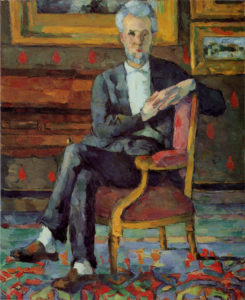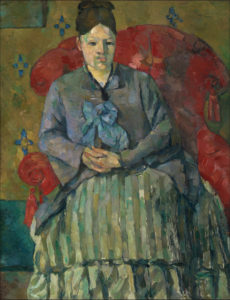R296 – Portrait de Victor Chocquet assis, vers 1877 (FWN439)
Pavel Machotka
(Cliquer sur l’image pour l’agrandir)
The two portraits that most closely reflect the Cézanne’s emphasis of 1877 on the consistency of the painting’s surface are the Portrait of Victor Chocquet seated and the one of Mme Cézanne in a striped skirt (R324-FWN443). Chocquet now sits as if he had been placed on the canvas rather than in his living room: his body is a series of verticals and horizontals parallel to the frame and even his crossed legs are squished together to remain close to the vertical. His locked hands form the one diagonal line, which is opposed to an implied diagonal: the receding bottom of the chair. In all respects the picture is flat—an object to hold or to look at, not a window to look through—and we gaze at its repetitive patterns rather than at a person in space. The repetitive patterns are everywhere: in the consistent widths of the many parallel lines—the picture frames, the bureau, the rug pattern, and even the interlaced fingers—in the size of the blocks of paint that define each surface, and in the brilliant spots of red that leap away from the wall and carpet.
Source: Machotka, Cézanne: the Eye and the Mind.
Voir aussi pour l’iconographie de Chocquet le Portrait de Victor Chocquet.




Vous devez être connecté pour poster un commentaire.